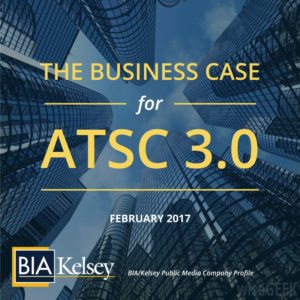- About
- Members
- Sponsors
- Subcommittees
- Technical Documents
- News
- Events
- Spotlight ATSC 3.0
- Contact Us
- Member Login
- Member Meetings
- Advanced Search
Search Site
Member Links
- About
- Members
- Sponsors
- Subcommittees
- Technical Documents
- News
- Events
- Spotlight ATSC 3.0
- Contact Us
- Member Login
- Member Meetings
- Advanced Search
Drive New Services, Revenues for TV Stations
Posted on April 3, 2017 in ATSC News

The investments that large- and medium-market TV stations make in Next Gen TV using the ATSC 3.0 standard can be recouped within three years, according to a new study of the commercial television broadcasting business by BIA/Kelsey.
“The Business Case for ATSC 3.0” examines Next Gen TV from a business perspective by exploring the advantages this new standard will bring to the industry, in particular as it relates to ad revenue, television viewership and managing digital competition.
According to the report, at the core of broadcasters’ ATSC 3.0 expectations is the ability to offer a new Internet Protocol platform to better satisfy the changing needs of consumers and advertisers. BIA/Kelsey says ATSC 3.0 business objectives for the broadcasting industry include:
- Maintaining or increasing viewership by offering superior service to their viewing audience, including the delivery of a higher quality experience, more programming options, and ongoing innovation to accommodate abrupt changing viewing patterns;
- Raising advertising revenue through increased viewership, better ad targeting, dramatically expanded and more accurate viewership tracking, and a capability to better integrate multiplatform campaigns; and
- Growing non-advertising revenue through the development of new IP-based broadcasting and non-broadcasting business models as the business of television broadcasting morphs into a broader content distribution service.
“ATSC 3.0 will change the business of broadcasting into a next-generation wireless communications business. This new technology will give broadcasters the ability to pursue multiple new business models, which will significantly diversify their current revenue mix,” said Mark Fratrik, BIA/Kelsey Senior VP and chief economist.
Posted in ATSC News
News Categories
News Archives
Subscribe
Subscribe to The Standard, our monthly newsletter. Learn More
Join ATSC
ATSC is a membership organization with both voting and observer categories. Voting members include corporations, nonprofit organizations, and government entities, and they participate actively in the work of ATSC. Observers are individuals or entities not eligible to be a voting member.
Subscribe to our Newsletter
Subscribe to The Standard, our monthly newsletter, to stay up-to-date with ATSC news and events around the world.
Site Links
Contact Us
Advanced Television Systems Committee, Inc.
1300 I Street NW, Suite 400E
Washington, DC 20005
Do you have questions about ATSC?
About ATSC
The Advanced Television Systems Committee, Inc., is an international, non-profit organization developing voluntary standards and recommended practices for digital terrestrial broadcasting. ATSC member organizations represent the broadcast, broadcast equipment, motion picture, consumer electronics, computer, cable, satellite, and semiconductor industries. ATSC also develops digital terrestrial broadcasting implementation strategies and supports educational activities on ATSC standards.
© 2024 ATSC








































